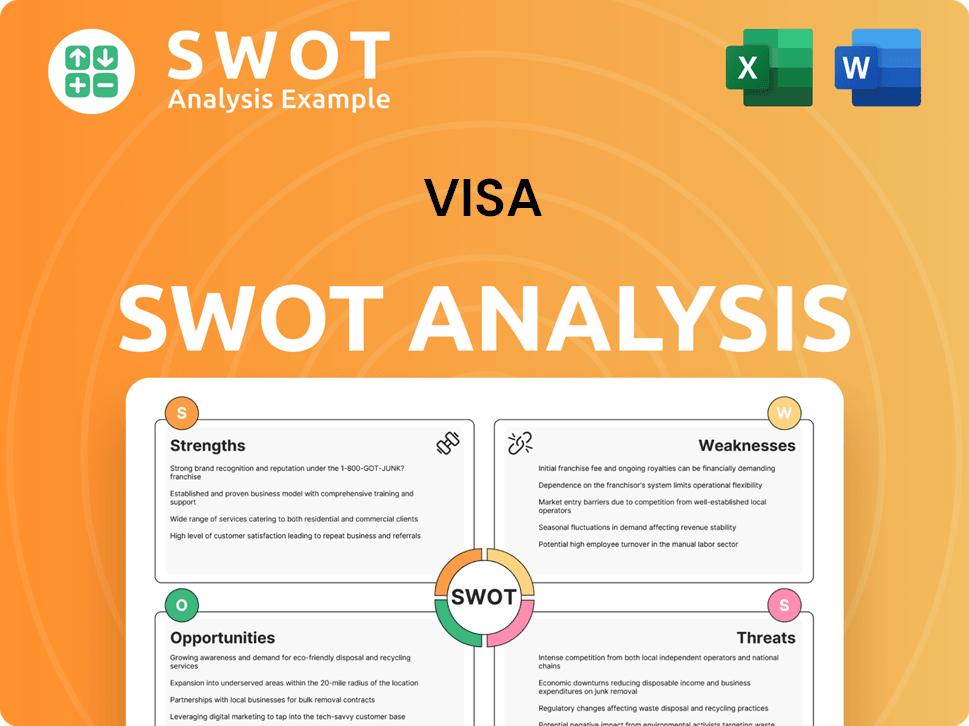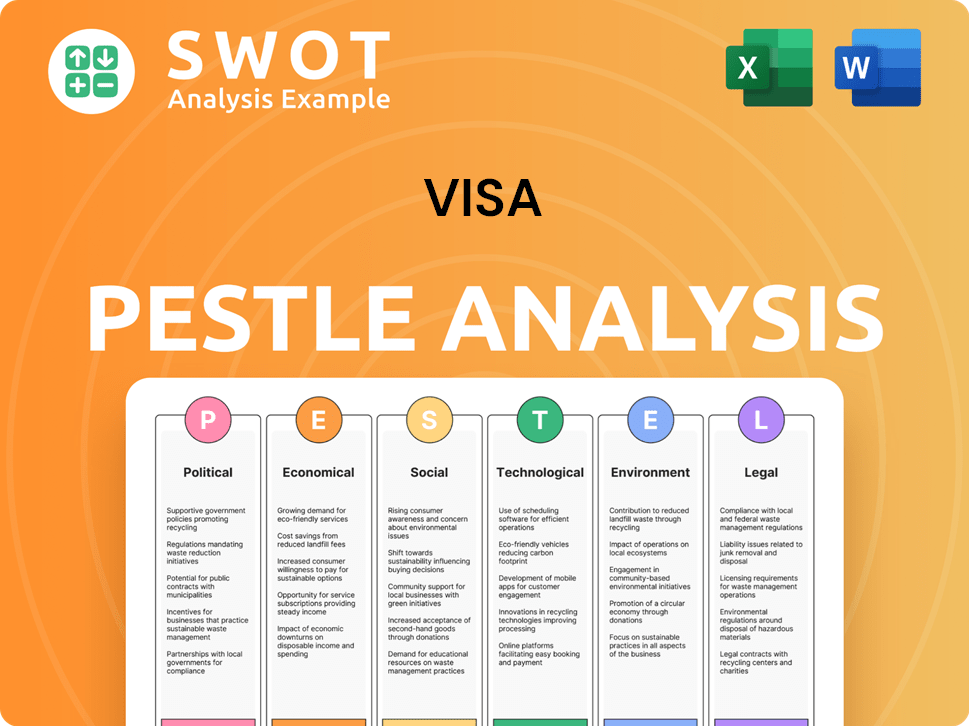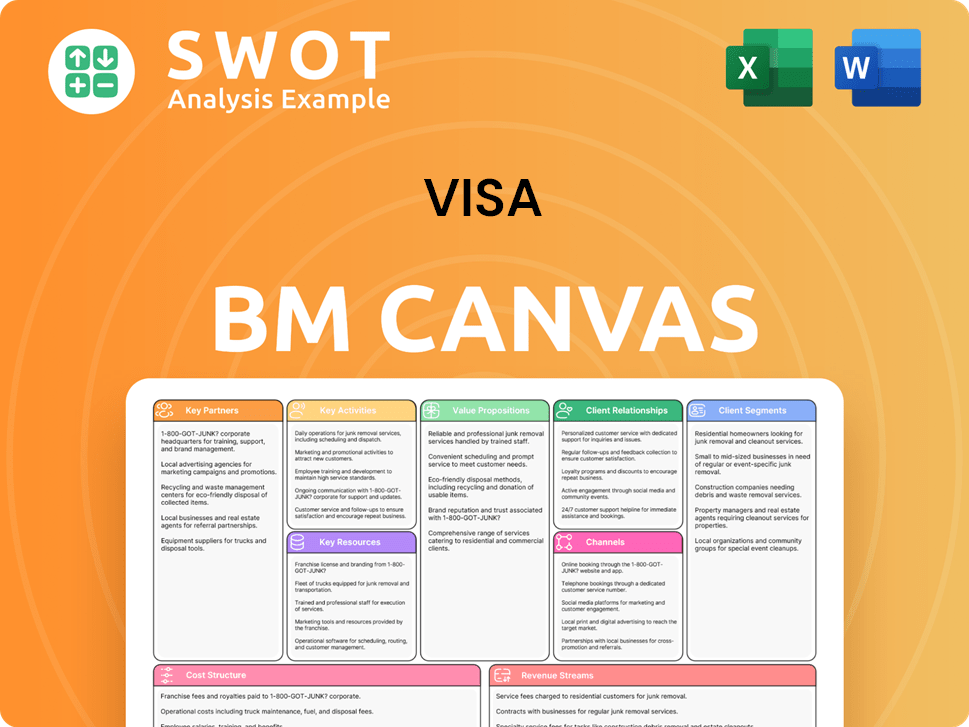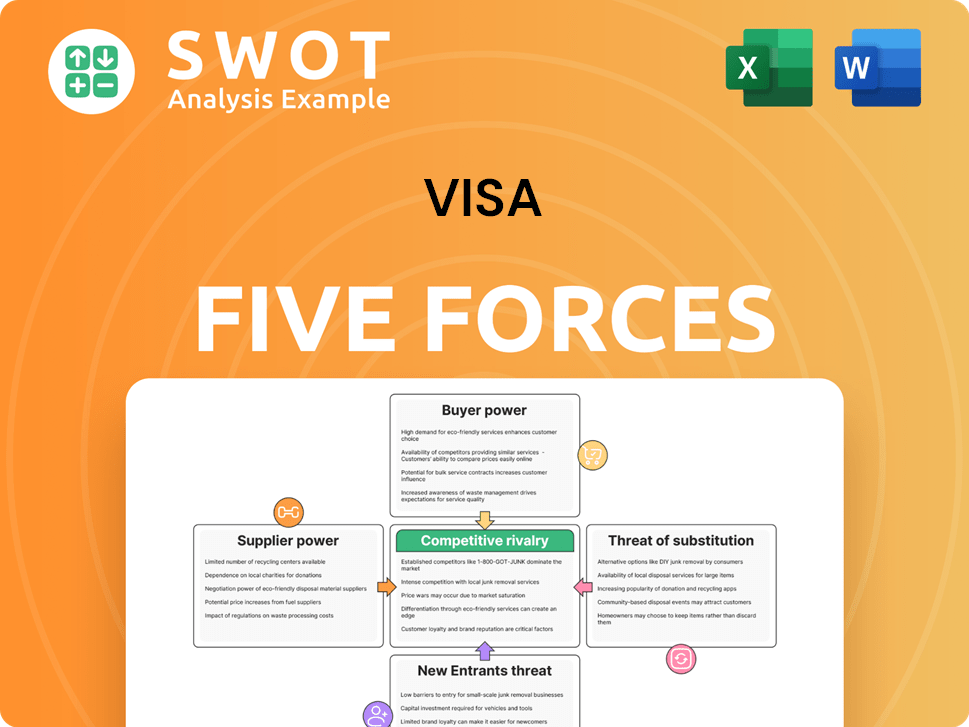Visa Bundle
Who Really Owns Visa?
Delving into 'Who owns Visa Company?' unveils a fascinating story of financial evolution. From its inception as BankAmericard in 1958 to its current status as a global payments giant, Visa's ownership structure has undergone a dramatic transformation. Understanding Visa's ownership is key to grasping its strategic direction and market influence.

Visa Inc, now a publicly traded entity with its Visa SWOT Analysis showing its strengths, weaknesses, opportunities, and threats, has a complex ownership landscape. The company, with its Visa headquarters in San Francisco, is a powerhouse in the financial world, boasting a market capitalization exceeding $500 billion as of early 2025. This exploration will dissect Visa's ownership, from its early days to its current shareholders, offering insights into its governance and financial performance, answering questions like "Who are Visa's major investors?" and "Is Visa a public company?"
Who Founded Visa?
The story of the company, now known as Visa, began in 1958 with Bank of America's introduction of BankAmericard. The driving force behind this innovative payment system was Joseph P. Williams, an executive at Bank of America. Initially, Bank of America held complete control and ownership of the credit card program.
The company's ownership structure evolved from a single-entity model to a more collaborative one. This shift was a critical step in its development. This early structure set the stage for the global payment network it would become.
The initial ownership of the credit card program was entirely within Bank of America. The bank managed all financial risks and gained all the rewards. This structure was a centralized model.
Bank of America launched BankAmericard in 1958. This marked the beginning of what would become a global payment system.
Joseph P. Williams, an executive at Bank of America, was instrumental in creating BankAmericard. He spearheaded the development of the credit card program.
Initially, Bank of America had sole ownership and control of BankAmericard. The bank managed all aspects of the program.
In 1966, Bank of America began licensing the program to other banks. This was a move toward a more distributed model.
The licensing model allowed other financial institutions to issue BankAmericard products. This expanded the network.
Early agreements focused on operational standards and interchange fees. This set the foundation for a cooperative network.
The shift to a licensing model in 1966 was a pivotal moment in the history of the company. This allowed other banks to issue cards under their own names, expanding the network beyond Bank of America. This was a key step in the evolution of the company's ownership structure. The move to license the system aimed to overcome geographical and institutional barriers. For more details on the company's market, you can read about the Target Market of Visa.
Understanding the early ownership of the company is crucial to grasping its current structure. The company's evolution from a single-entity to a collaborative network shows its growth.
- The company's origins are with Bank of America's BankAmericard in 1958.
- Joseph P. Williams was the visionary behind the BankAmericard.
- Initially, Bank of America solely owned and controlled the program.
- In 1966, the company began licensing the program to other banks.
Visa SWOT Analysis
- Complete SWOT Breakdown
- Fully Customizable
- Editable in Excel & Word
- Professional Formatting
- Investor-Ready Format

How Has Visa’s Ownership Changed Over Time?
The evolution of Who Owns Visa, a pivotal shift occurred in March 2008 with its Initial Public Offering (IPO). This landmark event raised approximately $17.9 billion, marking it as one of the largest IPOs in U.S. history at the time. Before the IPO, the Visa company functioned as a private membership association, owned by thousands of financial institutions globally. These banks, which issued Visa cards, essentially owned the company, shaping its strategy and governance based on their collective interests.
The IPO fundamentally changed this structure, transforming the association into a publicly traded corporation, Visa Inc. This transition allowed for broader ownership, including institutional investors, mutual funds, index funds, and individual shareholders. As of early 2025, major institutional investors hold significant stakes in Visa ownership. For instance, Vanguard Group Inc. and BlackRock Inc. are consistently among the top institutional shareholders. These firms, along with other large asset managers, collectively hold a substantial percentage of Visa's outstanding shares. Individual insiders also maintain stakes through stock options and direct share ownership. This shift has led to greater transparency and a focus on shareholder value, increasing scrutiny from financial markets. This evolution has also facilitated strategic investments and acquisitions.
| Aspect | Details | Impact |
|---|---|---|
| Pre-IPO Ownership | Owned by thousands of financial institutions. | Strategy and governance driven by bank interests. |
| IPO Date | March 2008 | Transition to a publicly traded company. |
| IPO Proceeds | $17.9 billion | One of the largest IPOs in U.S. history. |
The transition to a public company has significantly impacted Visa's corporate governance and strategic direction. The shift has moved the company towards greater transparency and a stronger focus on shareholder value. For anyone interested in understanding how Visa approaches its market, you can explore the Marketing Strategy of Visa.
Visa shareholders now include a diverse group of institutional and individual investors. The IPO in 2008 was a pivotal moment, transforming the company's ownership structure. The company's financial performance is closely watched by market analysts and investors.
- The IPO was a major event in financial history.
- Institutional investors hold significant stakes.
- Greater transparency and shareholder value focus.
- Strategic investments and acquisitions are now easier.
Visa PESTLE Analysis
- Covers All 6 PESTLE Categories
- No Research Needed – Save Hours of Work
- Built by Experts, Trusted by Consultants
- Instant Download, Ready to Use
- 100% Editable, Fully Customizable

Who Sits on Visa’s Board?
The Board of Directors of Visa Inc., as of early 2025, oversees the company's governance, balancing the interests of its diverse ownership. The board typically includes independent directors and individuals with financial industry experience. The composition of the board is detailed in Visa's annual proxy statements (DEF 14A filings with the SEC), released in late 2024 or early 2025 for the upcoming annual meeting. The board members are elected by Visa shareholders.
The board's role is crucial in steering Visa through the evolving payment technologies and regulatory landscapes. Discussions often center on executive compensation and environmental, social, and governance (ESG) initiatives. This reflects the board's commitment to aligning with shareholder expectations and maintaining corporate responsibility. The board's decisions are influenced by the company's performance and strategic direction.
| Board Member | Title | Relevant Experience |
|---|---|---|
| Alfred F. Kelly, Jr. | Executive Chairman | Former Chairman and CEO of Visa Inc. |
| Ryan McInerney | Chief Executive Officer | Extensive experience in financial services and payments. |
| Vasant Prabhu | Vice Chairman | Former CFO of Visa; experience in financial services. |
Visa operates under a one-share-one-vote structure. Each share of common stock entitles its holder to one vote on matters brought before shareholders, including the election of directors. This structure ensures that institutional investors, given their substantial holdings, wield significant influence through their collective voting power. For more insights, you can explore the Growth Strategy of Visa.
Visa's board consists of experienced professionals, ensuring effective governance. The board's composition is detailed in annual proxy statements. The one-share-one-vote structure empowers all Visa shareholders.
- The board includes independent directors and industry experts.
- Shareholders elect the board members.
- Visa maintains a transparent voting structure.
- The board focuses on strategic initiatives and shareholder value.
Visa Business Model Canvas
- Complete 9-Block Business Model Canvas
- Effortlessly Communicate Your Business Strategy
- Investor-Ready BMC Format
- 100% Editable and Customizable
- Clear and Structured Layout

What Recent Changes Have Shaped Visa’s Ownership Landscape?
Over the past few years, the ownership of the Visa company has seen continuous evolution, mirroring broader trends in the financial technology sector. A key aspect has been the consistent execution of share buyback programs, a strategic move to return value to shareholders and reduce the total number of outstanding shares. Visa has regularly authorized significant share repurchase programs, often exceeding $10 billion annually. This strategy has a direct impact on the ownership percentages of existing shareholders by consolidating the share base. While secondary offerings are less common for a mature entity like Visa, strategic mergers and acquisitions continue to shape its market position and, indirectly, its ownership landscape.
The influence of institutional investors, including passive investment vehicles like index funds and ETFs, remains a prominent feature of Visa's ownership structure. These entities hold substantial and growing stakes, contributing to a more stable, long-term ownership base. This trend means that Visa is increasingly influenced by the investment policies and governance priorities of these large asset managers. The company's commitment to its current ownership model is evident, with no major public statements or analyst indications suggesting a planned privatization or a significant shift in its public listing status in the near future. For a deeper dive into the company's origins, you can explore the Brief History of Visa.
Share buybacks are a key strategy, with authorizations often exceeding $10 billion annually. Institutional investors, including ETFs, hold substantial stakes, contributing to a stable ownership base. No major shifts in public listing status are anticipated, indicating a continued commitment to the current ownership model.
Major institutional investors and passive investment vehicles play a significant role. Shareholder composition is influenced by the company's strategic decisions, including mergers and acquisitions. These factors shape who owns Visa and the dynamics of its shareholder base.
Visa Porter's Five Forces Analysis
- Covers All 5 Competitive Forces in Detail
- Structured for Consultants, Students, and Founders
- 100% Editable in Microsoft Word & Excel
- Instant Digital Download – Use Immediately
- Compatible with Mac & PC – Fully Unlocked

Related Blogs
- What are Mission Vision & Core Values of Visa Company?
- What is Competitive Landscape of Visa Company?
- What is Growth Strategy and Future Prospects of Visa Company?
- How Does Visa Company Work?
- What is Sales and Marketing Strategy of Visa Company?
- What is Brief History of Visa Company?
- What is Customer Demographics and Target Market of Visa Company?
Disclaimer
All information, articles, and product details provided on this website are for general informational and educational purposes only. We do not claim any ownership over, nor do we intend to infringe upon, any trademarks, copyrights, logos, brand names, or other intellectual property mentioned or depicted on this site. Such intellectual property remains the property of its respective owners, and any references here are made solely for identification or informational purposes, without implying any affiliation, endorsement, or partnership.
We make no representations or warranties, express or implied, regarding the accuracy, completeness, or suitability of any content or products presented. Nothing on this website should be construed as legal, tax, investment, financial, medical, or other professional advice. In addition, no part of this site—including articles or product references—constitutes a solicitation, recommendation, endorsement, advertisement, or offer to buy or sell any securities, franchises, or other financial instruments, particularly in jurisdictions where such activity would be unlawful.
All content is of a general nature and may not address the specific circumstances of any individual or entity. It is not a substitute for professional advice or services. Any actions you take based on the information provided here are strictly at your own risk. You accept full responsibility for any decisions or outcomes arising from your use of this website and agree to release us from any liability in connection with your use of, or reliance upon, the content or products found herein.